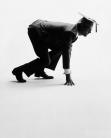Objective Case
Objective Case :
The objective case, as its name implies, is the case of the object. Most of its uses are covered by the following rule.
The object of a verb or preposition is in the objective case.
The object of a preposition has already been explained and defined.
The object of a verb may be (1) the direct object (2) the predicate objective (3) the indirect object and (4) the cognate object. Of these the direct object is the most important.
The objective is also used (5) adverbially (6) in apposition with another objective and (7) as the subject of an infinitive.
Objective Case and Direct Object
Some verbs may be followed by a substantive denoting that which receives the action or is produced by it. These are called transitive verbs. All other verbs are called intransitive verbs.
GROUP : 1
1. That man struck my dog.
2. The arrow hit the target.
3. Cesar conquered Gaul.
4. Mr. Holland sells flour.
5. The farmer raises corn.
6. Mr. Eaton makes stoves.
7. My grandfather built that house.
In 1, 2, 3 and 4 above, the verb is followed by a noun denoting the receiver of the action. Thus, in the first sentence, the dog receives the blow. In the second, the target receives the action of hitting.
In 5, 6 and 7 above, the verb is followed by a noun denoting the product of the action. For example, the corn is produced by the action expressed by the verb raises.
In each example, the noun that follows the verb completes the sense of the verb.
That man struck ——.
Struck whom?
He struck the dog.
Until dog is added the sense of the verb struck is incomplete.
A substantive that completes the meaning of a transitive verb is called its direct object and is said to be in the objective case.
Thus, in the examples above…
Dog is the direct object of the transitive verb struck.
Target is the direct object of hit.
Each of these nouns is therefore in the objective case.
The direct object is often called the object complement or the object of the verb.
Intransitive verbs have no object.
1. The lion roared.
2. The visitor coughed gently.
3. The log drifted downstream.
4. We all listened intently.
Compare these sentences with the sentences in GROUP : 1. We observe that the verbs admit no object, since their meaning is complete without the addition of any noun to denote the receiver or product of the action.
“The man struck——” prompts the inquiry, “Struck whom?”
But no such question is suggested by “The lion roared….” for “Roared what?” would be an absurdity.
The predicate nominative must not be confused with the direct object. They resemble each other in two particulars.
(1) Both stand in the predicate.
(2) Both complete the meaning of the verb.
But they differ utterly in their relation to the subject of the sentence. For….
The predicate nominative describes or defines the subject. Hence both substantives denote the same person or thing.
Charles [SUBJECT] {is | was | became | was elected} captain [PREDICATE NOMINATIVE].
The direct object neither describes nor defines the subject. On the contrary, it designates that upon which the subject acts. Hence the two substantives regularly18 denote different persons or things.
Charles [SUBJECT] {struck James [OBJECT]. | threw a stone [OBJECT]. | built a boat [OBJECT].}
Both the direct object and the predicate nominative are classed as complements, because they are used to complete the sense of the predicate verb.
A verb of asking sometimes takes two direct objects, one denoting the person and the other the thing.
1. She asked the boy his name.
2. Ask me no favors.
3. I asked the lawyer his opinion.
Objective Case :
Objective Case To HOME PAGE

Related Links : Objective Case